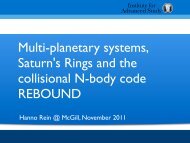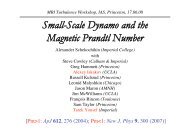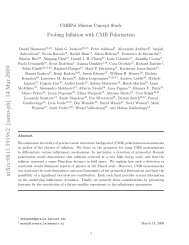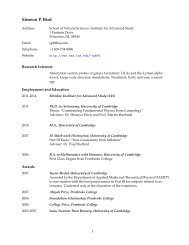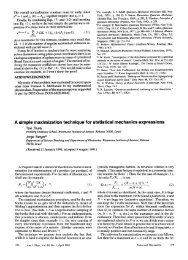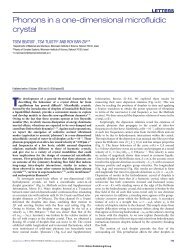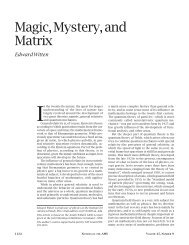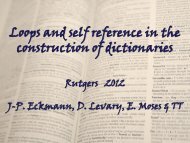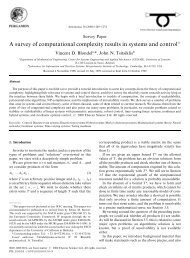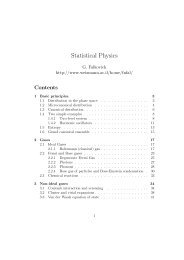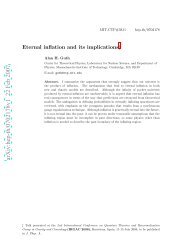Introduction to String Theory and D–Branes - School of Natural ...
Introduction to String Theory and D–Branes - School of Natural ...
Introduction to String Theory and D–Branes - School of Natural ...
You also want an ePaper? Increase the reach of your titles
YUMPU automatically turns print PDFs into web optimized ePapers that Google loves.
In general, the complete theory is <strong>of</strong>ten thought <strong>of</strong> as a conformal field theory <strong>of</strong> central charge c coupled<br />
<strong>to</strong> two dimensional gravity. The gravity here refers <strong>to</strong> the physics <strong>of</strong> the two dimensional metric. This nomenclature<br />
is consistent with the fact that the Riemann tensor in d dimensions has d 2 (d 2 − 1)/12 independent<br />
components, so that in d = 2 there is one degree <strong>of</strong> freedom, that represented by ϕ.<br />
For example, with just one ordinary scalar X, (which has c = 1), we have two dimensional string theory.<br />
The spacetime picture that is kept in mind for this model is that ϕ plays the role <strong>of</strong> a spatial coordinate,<br />
<strong>and</strong> time is recovered by Wick rotating X. Notice that the spacetime picture meshes very nicely with<br />
the σ–model approach we worked with in equation (93). Comparing our Liouville theory Lagrangian with<br />
that <strong>of</strong> the sigma model we see that the dila<strong>to</strong>n is set by ϕ as Φ = Qϕ/( √ 2α ′ ). Choose the spacetime<br />
metric as flat: Gµν = ηµν. This “linear dila<strong>to</strong>n vacuum” is a solution <strong>to</strong> the β–function equations (96) if<br />
Q = (26 − D)/3 = (25 − c)/3, as we saw above (where we have D = 2 for the case in h<strong>and</strong>). Since the<br />
string coupling is set by the dila<strong>to</strong>n via gs = e Φ , we see that our earlier statement that ϕ → −∞ is weak<br />
coupling is indeed correct. Further <strong>to</strong> this, we see that the case <strong>of</strong> larger ϕ is at stronger coupling. Note<br />
that µ sets a natural scale where the cosmological term is <strong>of</strong> order one <strong>and</strong> the theory is firmly in the strong<br />
coupling regime, at ϕ ∼ log(1/µ). This is <strong>of</strong>ten referred <strong>to</strong> the “Liouville Wall”, the demarcation between<br />
the strong <strong>and</strong> weak coupling regimes.<br />
Turning <strong>to</strong> other cases, the most well–studied conformal field theories are the c < 1 minimal models, an<br />
infinite family indexed by two integers (p, q) with<br />
c = 1 −<br />
6(p − q)2<br />
pq<br />
. (173)<br />
These models are distinguished by (among other things) having a finite number <strong>of</strong> primary fields. They<br />
are unitary when |p − q| = 1. The trivial model is the (3, 2), which has c = 0. Two other famous unitary<br />
members <strong>of</strong> the series are (4, 3), which has c = 1/2 <strong>and</strong> (5, 4), which has c = 7/10 are the critical Ising model<br />
<strong>and</strong> the tricritical Ising model.<br />
For the (3, 2) coupled <strong>to</strong> Liouville, we see that the model is just one with no extra embedding for the<br />
string at all, just the Liouville dimension. It is <strong>of</strong>ten referred <strong>to</strong> as “pure gravity”, since the (non–Liouville)<br />
conformal field theory is trivial. In general, the study <strong>of</strong> these “non–critical string theories” is said <strong>to</strong> be the<br />
study <strong>of</strong> strings in D ≤ 2.<br />
Remarkably, the path integral for these models can be supplied with a definition using the techniques<br />
called “Matrix Models”. Basically, the sum over world–sheet metrics is performed by studying the theory <strong>of</strong><br />
an N×N matrix valued field, where N is large. The matrix integral can be exp<strong>and</strong>ed in terms <strong>of</strong> Feynmann<br />
diagrams, <strong>and</strong> for large N, the diagrams can be organized in terms <strong>of</strong> powers <strong>of</strong> 1/N. This expansion in<br />
1/N is the same as the gs <strong>to</strong>pological expansion <strong>of</strong> string perturbation theory, <strong>and</strong> the Feynmann diagrams<br />
act as a sort <strong>of</strong> regularized representation <strong>of</strong> the string world–sheets. We don’t have time or space <strong>to</strong> study<br />
these models here, but it is a remarkable subject. In fact, it is in these simple string models that a lot <strong>of</strong><br />
the important modern string ideas have their roots, such as non–perturbative string theory, the behaviour<br />
<strong>of</strong> string theory at high orders in perturbation theory, <strong>and</strong> non–perturbative relations between open <strong>and</strong><br />
closed strings 7 . Recently, this area has been revisited, as it has become increasingly clear that there may be<br />
more lessons <strong>to</strong> be learned about the above <strong>to</strong>pics <strong>and</strong> more, such as holography, tachyon condensation, <strong>and</strong><br />
open–closed transitions 8 .<br />
There has yet <strong>to</strong> be presented a satisfac<strong>to</strong>ry interpretation for the physics for a vast range <strong>of</strong> dimensions,<br />
however. This is because it is only for the case 0 ≤ c ≤ 1 that Q <strong>and</strong> γ are both real. Outside this range,<br />
the above formulae <strong>of</strong> non–critical string theory await a physical interpretation.<br />
7 For a review <strong>of</strong> the subject, see for example refs.[10]<br />
8 There is no complete review <strong>of</strong> this area currently available (although see the last <strong>of</strong> refs.[10]), so it is recommended that<br />
refs.[11] be consulted, as their opening sections give a good guide <strong>to</strong> the literature, old <strong>and</strong> new.<br />
44



